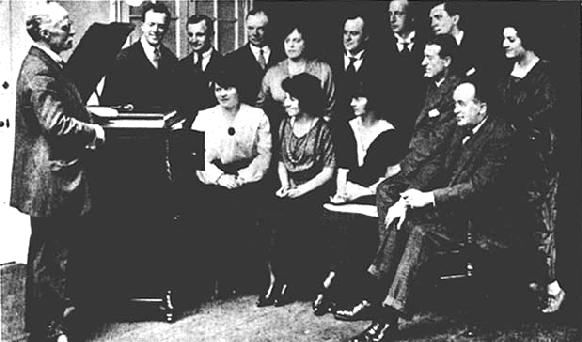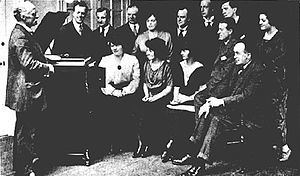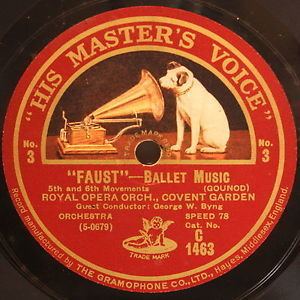Name George Byng Role Conductor | Died 1932 | |
 | ||
George Wilford Buckley Byng (1861 – 29 June 1932) was an English conductor, composer, music arranger and musical director of the late 19th and early 20th centuries. He is known for composing music for ballet productions staged at the Alhambra Theatre in London during the Edwardian era, for his theatre compositions and as a conductor for HMV from World War I up to about 1930.
Contents

As a child, he received a musical education and at age 11 joined the orchestra at the Theatre Royal, Dublin. He played in orchestras throughout Britain for two decades before beginning a conducting career. By the 1890s, his compositions of incidental music for plays were used in London theatres. From 1898 to 1913, as the musical director of London's Alhambra Theatre, he composed, arranged and conducted the music for approximately 30 ballets and scenas. During this period, he continued to compose new music, including theatre scores, for other companies. For two years thereafter, he was the musical conductor at the Gaiety Theatre, London.

After conducting for Thomas Edison's British recording studio for several years, in 1915 Byng joined HMV full-time, where he conducted a great number of recordings. From 1917 to 1924, he conducted many of the early acoustic sets of the Gilbert and Sullivan operas in cooperation with the D'Oyly Carte Opera Company. He remained with HMV for at least 15 years.
Early years
Byng was born in Whitehaven, Cumberland, England. At the age of seven he entered the Royal Irish Academy of Music in Dublin. Four years later he joined the orchestra at the Theatre Royal, Dublin, of which he remained a member for six years. Later engagements in orchestras were at the Gaiety Theatre, Dublin; the Theatre Royal, Edinburgh; the Prince's Theatre, Manchester; and, in London, the Gaiety; the Shaftesbury and the Royalty. For three years he was sub-conductor in London at the Empire, Leicester Square, before being appointed musical director at the Prince of Wales Theatre. He composed incidental music for the play Six Persons, which was staged at the Haymarket Theatre in London in the 1893–94 season. Together with A McLean and Reginald Somerville he composed the score for the musical farce, The White Silk Dress, which opened at The Prince of Wales's Theatre in 1896, starring Decima Moore and Arthur Roberts.
Musical director and composer
In 1898 Byng succeeded Georges Jacobi as musical director of the Alhambra Theatre in London. The Alhambra maintained a large corps de ballet and engaged well known choreographers. The music was generally arranged by the theatre's musical director. Byng composed, arranged and conducted the music for approximately 30 ballets and scenas. Carmen was one of the popular ballets produced at this theatre and was seen in at least three different versions: 20 October 1897, with choreography by A. Bertrand and music by Jacobi; in 1903 with choreography by Lucia Cormani and music by Georges Bizet and Byng; and again in 1912 with choreography by Augustin Berger and music by Bizet, Byng and George Clutsam. Also in 1912, Byng constructed a score for The Guide to Paris, an updated version of La Vie parisienne with words by George Grossmith, Jr.; Byng included music from other Offenbach scores, including La belle Hélène, Madame Favart and Barbe-bleue.
Byng listed his principal compositions as Jack Ashore, Inspiration, Gretna-Green, Santa Claus, The Devil's Forge, On the Heath, Our Flag and H.M.S. Irresponsible. The last was a musical play by J F Cornish, which was staged on Broadway in 1900 before opening at the Strand Theatre in May 1901. Byng composed music for several other stage shows, including The Variety Girl (1902), The Belle of the Baltic, Guy Fawkes, The Duchess of Sillie Crankie (1904), and The Mad Pierrot (1911). His other songs and compositions include "Cupid Wins", "The Two Flags", "Paquita", "The Polar Star", "Femina", "On the Sands", "My sword and I" (sung by Peter Dawson), "My Heart and I" (duet) and an orchestral suite: A Day in Naples
In 1913 he left the Alhambra and was appointed musical conductor at the Gaiety Theatre, London in succession to Leopold Wenzel. He also conducted light/dance orchestras, for example the Queen's Hall Light Orchestra and the Mayfair Orchestra.
HMV years
Byng first conducted for recordings at Thomas Edison's London studios from 1909 until the studio closed in 1914. In 1915 Byng became staff conductor for HMV and conducted a great number of recordings made at their recording studios in Hayes, Middlesex. These featured many well-known artists of the time, for example the singers Elisabeth Schumann, Feodor Chaliapin, Peter Dawson, the Black Diamonds (Brass) Band and the Mayfair Dance Orchestra.
During and after World War I Byng was one of the conductors, along with Arthur Wood and Harry Norris, who worked on the HMV project to record the Gilbert and Sullivan comic operas. This was an extensive undertaking with the recordings being overseen by the D'Oyly Carte Opera Company. The following is a list of the Gilbert and Sullivan recordings in which he participated:
In 1930 he was both arranger and conductor of a series of children's records and other music for light orchestra recorded by HMV in one of the studios at the Small Queen's Hall in London.
Death
Although still working for HMV until at least 1930, during 1931 or 1932 he was admitted to the asylum at "Northwoods House" in Frampton Cotterell, Gloucestershire. On 29 June 1932, he died there as a result of self-inflicted wounds to his throat, aged 71.
